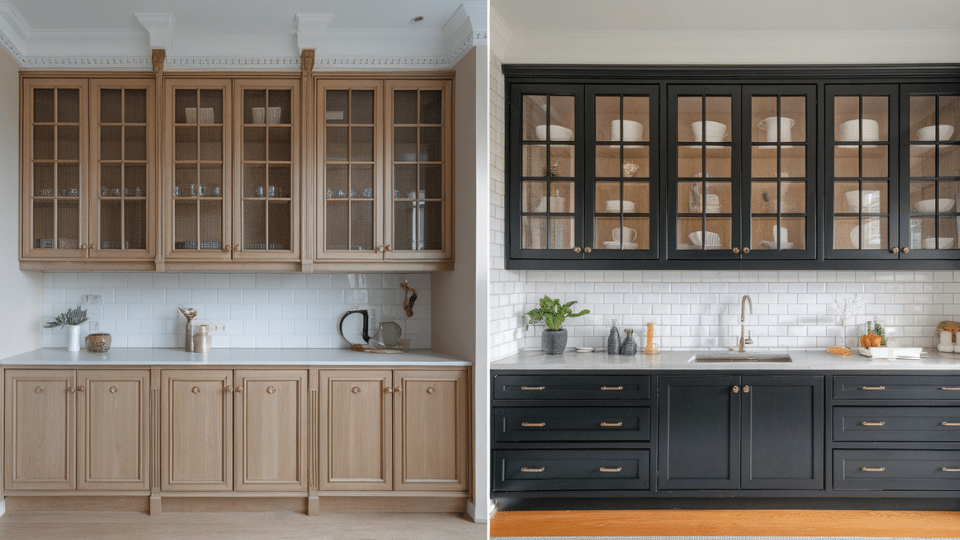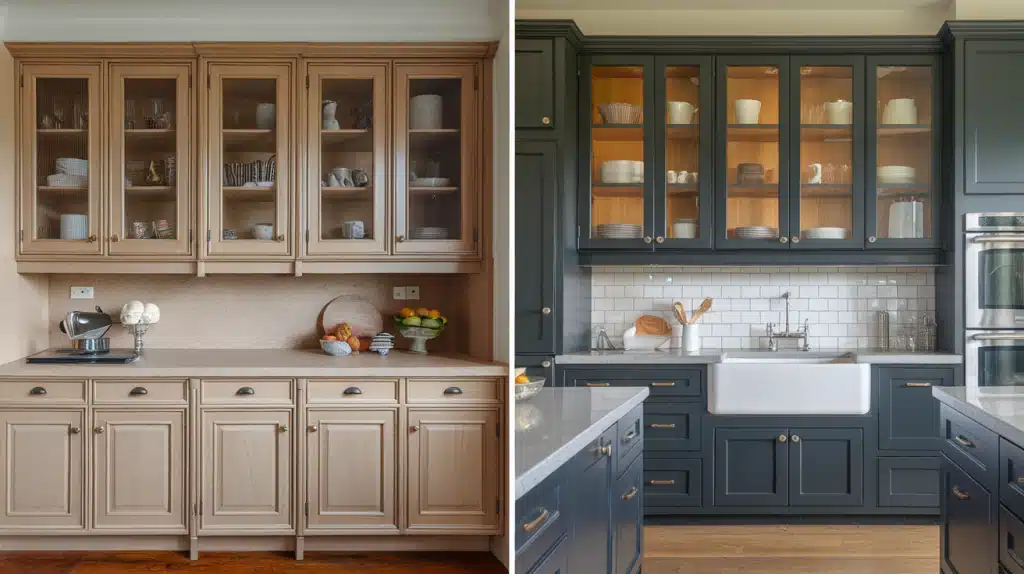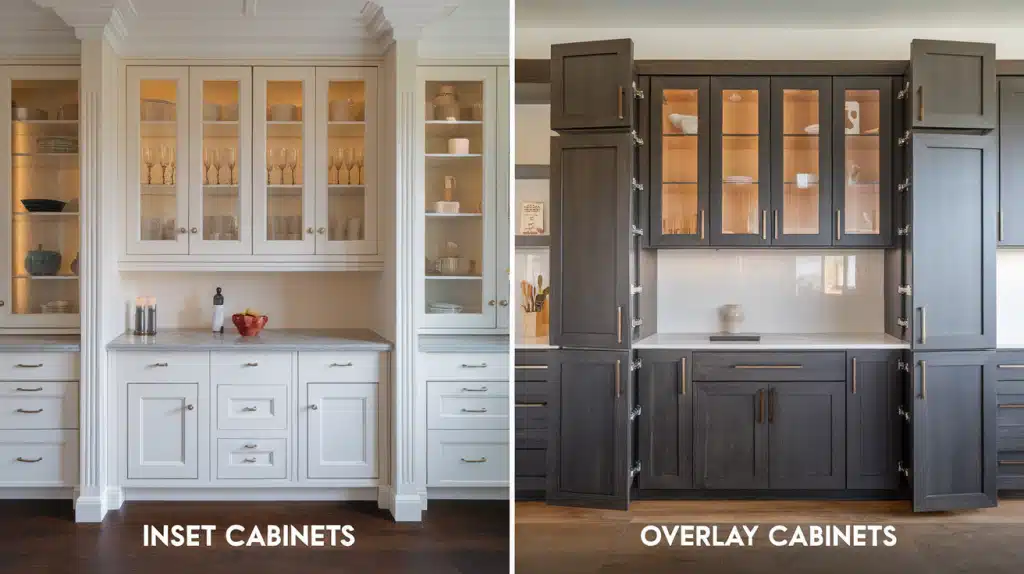Planning a kitchen remodel? The cabinet style you choose will define your entire space for years to come.
Two popular options dominate the market today: inset and overlay cabinets. Each offers distinct benefits that can significantly impact your kitchen’s functionality and appearance.
Inset cabinets sit flush inside their frames, creating that coveted furniture-quality look. Overlay cabinets rest on top of frames, offering maximum storage and budget-friendly pricing. But which one fits your lifestyle?
The difference goes beyond looks. Your choice affects storage capacity, maintenance needs, installation costs, and long-term satisfaction. Some homeowners love the clean lines of inset doors, while others prefer the practical advantages of overlays.
This guide provides a comprehensive overview of everything you need to know. We’ll compare costs, storage, durability, and design compatibility.
By the end, you’ll confidently choose the cabinet style that perfectly matches your needs, budget, and dream kitchen vision.
What Are Inset Cabinets?
Inset cabinets are a premium cabinet style where the doors and drawers sit completely flush inside the cabinet frame, creating a smooth, uninterrupted surface.
This construction method requires precise measurements since the door fits snugly within the frame opening rather than overlapping it. Rooted in traditional American craftsmanship, inset cabinets became popular in the early 1900s and remain a hallmark of high-end, furniture-quality cabinetry today.
They’re typically crafted from solid hardwoods like maple, oak, or cherry; however, painted finishes on high-quality plywood are also common, giving kitchens a timeless, built-in furniture appearance that never goes out of style.
Pros and Cons of Inset Cabinets
| Pros of Inset Cabinets | Cons of Inset Cabinets |
|---|---|
| Clean, seamless aesthetic | Higher cost due to precise construction |
| High-end, furniture-like appearance | Slightly less interior storage space |
| Exceptional craftsmanship and long-term durability | Prone to expansion or contraction in humid environments |
What Are Overlay Cabinets?
Overlay cabinets feature doors and drawers that sit on top of the cabinet frame, covering either part or all of the frame face for a more contemporary look.
There are two main types: partial overlay cabinets cover about half the frame and show visible gaps between doors. In contrast, full overlay cabinets cover nearly the entire frame with minimal gaps between doors.
Most popular in modern and transitional kitchens, overlay cabinets provide a clean, streamlined appearance that complements both sleek contemporary designs and casual transitional styles.
They’re typically made from various materials, including plywood, MDF, or solid wood, and can be finished with paint, stain, or laminate to match any design preference.
Pros and Cons of Overlay Cabinets
| Pros of Overlay Cabinets | Cons of Overlay Cabinets |
|---|---|
| More interior storage space | Less custom appearance, may look mass-produced |
| Lower cost compared to inset cabinets | Hinges may be visible in partial overlay styles |
| Easier installation and door alignment | Gaps between cabinet doors can collect dust |
Key Differences Between Inset and Overlay Cabinets
While both inset and overlay cabinets serve the same functional purpose, their visual design, construction, cost, and performance differ significantly.
1. Visual Comparison
Inset – Creates a flat, flush surface where doors sit inside the frame opening. The frame is visible around each door, giving a furniture-like appearance. Gaps between doors are consistent and minimal, creating clean lines.
Overlay – Doors sit on top of the frame, covering most or all of it. Full overlay shows almost no frame, while partial overlay reveals frame sections between doors. The overall look is more streamlined and contemporary.
2. Cost Differences
Inset – Typically costs 20-40% more than overlay cabinets due to precise construction requirements. Requires skilled craftsmanship and more time to install properly. Premium materials and hardware add to the overall expense.
Overlay – More budget-friendly option with standard construction methods. A less labor-intensive installation process keeps costs down. A wide range of price points is available from basic to high-end finishes.
3. Space/Storage Capacity
Inset – Offers slightly less interior storage space since doors fit inside the frame. The frame takes up some interior room, reducing cabinet depth by about 3/4 inch. Better for those prioritizing style over maximum storage.
Overlay – Provides maximum interior storage capacity since doors don’t reduce internal space. Full overlay offers the most storage, while partial overlay still beats inset. Ideal for kitchens where every inch of storage matters.
4. Maintenance and Durability
Inset – Requires more careful maintenance as doors can stick in humid conditions. Wood expansion and contraction may cause alignment issues over time. Higher quality construction often means a longer lifespan with proper care.
Overlay – Generally easier to maintain with fewer alignment issues. Less affected by humidity and temperature changes. Hinges and hardware are typically easier to adjust and replace when needed.
5. Installation Requirements
Inset – Demands precise measurements and expert installation skills. Requires perfectly level and square cabinet boxes for proper door alignment. Installation takes longer and costs more due to complexity.
Overlay – More forgiving installation process with room for minor adjustments. Standard installation techniques work for most projects. Faster installation time helps keep labor costs reasonable.
6. Design Flexibility and Style Compatibility
Inset – Best suited for traditional, craftsman, and farmhouse kitchen styles. Limited hardware options due to precise fitting requirements. Creates a timeless, high-end look that works well with classic designs.
Overlay – Works with virtually any kitchen style from modern to traditional. A wide variety of hardware options and finishes are available. More versatile for changing design trends and personal preferences over time.
How to Choose the Right Cabinet Style for Your Kitchen?
Choosing between inset and overlay cabinets depends on four key factors that match your specific needs.
First, consider your budget; overlay cabinets cost significantly less and offer more bang for your buck, while inset cabinets require a premium investment for their luxury appeal.
Match your design style by selecting an inset for traditional, craftsman, or farmhouse kitchens, and an overlay for modern, contemporary, or transitional spaces.
Evaluate your storage needs if maximizing every inch of space is a priority; overlay cabinets provide more interior room. Still, if you prefer a furniture-quality look over storage, inset cabinets work better.
Finally, consider your climate – homes in humid areas may find overlay cabinets more practical since inset doors can accommodate wood expansion, while dry climates handle inset cabinets without major issues.
Maintenance Tips and Longevity for Cabinets
Inset Cabinets: Clean with gentle wood cleaner, adjust hinges seasonally to prevent sticking, and use dehumidifiers in humid climates to minimize wood expansion issues.
Overlay Cabinets: Wipe down regularly with mild soap, tighten loose hinges annually, and clean door gaps frequently to prevent dust buildup for maximum lifespan.
Summing It Up
Both inset and overlay cabinets have their place in modern kitchen design, and the right choice depends on your specific priorities.
Consider your lifestyle honestly. Do you value traditional craftsmanship over storage space? Is your budget flexible enough for premium construction? Will your climate affect door alignment over time? These answers will guide your decision.
Remember, both styles can create stunning kitchens when designed thoughtfully. Focus on quality construction, proper installation, and hardware that matches your daily use patterns.
Ready to move forward? Consult with a kitchen designer to see samples in person and discuss your specific space requirements. Your perfect kitchen awaits the right cabinet choice.
Frequently Asked Questions
Are Inset or Overlay Cabinets Better?
Neither is universally better – choose inset for luxury appeal, overlay for storage, and budget-friendliness.
What Are the Disadvantages of Inset Cabinets?
Higher cost, less storage space, and potential sticking issues in humid climates.
Are Overlay Cabinets Outdated?
No, overlay cabinets remain popular and work with modern, transitional, and traditional styles.
Are Inset Cabinets Worth the Extra Money?
Yes, if you prioritize premium aesthetics and have the budget for luxury craftsmanship.










